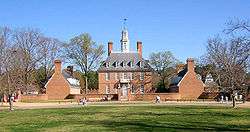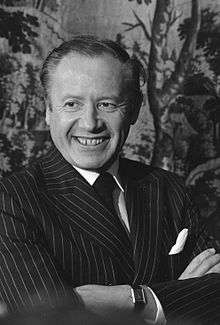9th G7 summit
| 9th G7 summit | |
|---|---|
 Governor's Palace in Williamsburg | |
| Host country | United States |
| Dates | May 28–29, 1983 |
| Follows | 8th G7 summit |
| Precedes | 10th G7 summit |
The 9th G7 Summit was held at Williamsburg, Virginia, United States during the 28th to 30 May 1983. The venue for the summit meetings was Colonial Williamsburg in Virginia.[1]
The Group of Seven (G7) was an unofficial forum which brought together the heads of the richest industrialized countries: France, West Germany, Italy, Japan, the United Kingdom, the United States, Canada (since 1976)[2] and the President of the European Commission (starting officially in 1981).[3] The summits were not meant to be linked formally with wider international institutions; and in fact, a mild rebellion against the stiff formality of other international meetings was a part of the genesis of cooperation between France's President Giscard d'Estaing and West Germany's Chancellor Helmut Schmidt as they conceived the first Group of Six (G6) summit in 1975.[4]
Leaders at the summit
_Pierre_Trudeau%2C_Gaston_Thorn%2C_Helmut..._-_NARA_-_198538.jpg)
The G7 is an unofficial annual forum for the leaders of Canada, the European Commission, France, Germany, Italy, Japan, the United Kingdom and the United States.[3] This was the first summit where none of the original participants from 1975 were still in office.
The 9th G7 summit was the first summit for German Chancellor Helmut Kohl, Italian Prime Minister Amintore Fanfani and Japanese Prime Minister Yasuhiro Nakasone.
Core G7 participants
These summit participants are the current "core members" of the international forum:[5][6]
| Core G7 members Host nation and leader are indicated in bold text. | |||
| Member | Represented by | Title | |
|---|---|---|---|
| |
Canada | Pierre Trudeau [1] | Prime Minister |
| |
France | François Mitterrand [1] | President |
| |
West Germany | Helmut Kohl [1] | Chancellor |
| |
Italy | Amintore Fanfani [1] | Prime Minister |
| |
Japan | Yasuhiro Nakasone [1] | Prime Minister |
| |
United Kingdom | Margaret Thatcher [1] | Prime Minister |
| |
United States | Ronald Reagan [1] | President |
| |
European Commission | Gaston Thorn [7] | President |
Issues
.jpg)
The summit was intended as a venue for resolving differences among its members. As a practical matter, the summit was also conceived as an opportunity for its members to give each other mutual encouragement in the face of difficult economic decisions.[4]
Meetings of the G7 focus on issues related to the economy and multinational efforts to connect these issues. However, talks led by President Reagan at this G7 Summit also concentrated on tensions with the Soviet Union and the need for missile deployment in Europe to encourage the Soviet Union to return to arms control talks in Geneva. A bilateral discussion was held between President Reagan and Prime Minister Thatcher prior to the G-7 meeting. Margaret Thatcher stressed the need to reaffirm the NATO double-track decision of 1979 approach to talks with the Soviets. Mrs. Thatcher and President Reagan agreed that it would be helpful to have G-7 reaffirm the decision. However, President Mitterrand and Prime Minister Trudeau were hesitant to agree. The first meeting of the leaders was head of state only. At the coffee hour Reagan appeared concerned that it would not be possible to get full agreement. Following the coffee break the first meeting of the Summit, President Reagan forged an agreement with the strong support of Prime Minister Nakasone of Japan, Chancellor Kohl of Germany and Prime Minister Thatcher. The need to deploy the Pershing II missiles was reached and reaffirmed. This decision showed the unity of Western leaders as they forged ahead to seek meaningful arms control agreements with the Soviet Union and it was a critical step in the arms control agreements reached between President Gorbachev and President Reagan two years later at the Geneva Summit, the first meeting between these two leaders.
In addition to the reinforcement of the double-track decision on arms control, the leaders were confronted with a stubborn world economy, double digit inflation, high interest rates and high employment. These economic conditions were stimulated, in part, due to higher oil prices in the early 1980s caused by the Iranian Revolution. The G-7 summit a year earlier had been held in Versailles, hosted by Prime Minister Mitterrand. Reagan felt that it was important to stress the importance of free markets and free trade and transparency in international dealings. After two days of debate, the leaders agreed to the Williamsburg Declaration,[8] which stands as quite unique in terms of G-7 communiques as it was a short ten point declaration and it was read in its entirety by President Reagan seated before the other leaders The significance of the Declaration cannot be over-emphasized as it was the free market principles agreed to by the leaders at the summit that provided an international environment of free trade and investment that propelled the world economies out of economic recession toward durable economic growth of twenty years.The declaration was prepared by a small team of NSC advisers close to Reagan.[9]
The Williamsburg Economic Summit was the only international meeting chaired by President Reagan. In retrospect it appears to have been the key turning point for not only ending the Cold War, but for inducing a period of economic prosperity based on free market policies.
Gallery
See also
Notes
- 1 2 3 4 5 6 7 8 "MOFA: List of Summit Meetings". mofa.go.jp.
- ↑ http://www.theglobeandmail.com/servlet/story/RTGAM.20080704.wG8-analysis05/BNStory/International/columnists
- 1 2 "FACTBOX: The Group of Eight: what is it?". Reuters UK.
- 1 2 Reinalda, Bob; Verbeek, Bertjan (1998). Autonomous Policy Making by International Organizations. p. 205.
- ↑ Lex Rieffel (27 March 2009). "Regional Voices in Global Governance: Looking to 2010". The Brookings Institution.
- ↑ http://g8.gc.ca/about/member-states/
- ↑ MOFA: Summit (9); European Union: "EU and the G8"
- ↑ "UTLink. G7 Economic Summit, Williamsburg, VA., 1983". utoronto.ca.
- ↑ Martin, William Flynn. "NSC Director of International Economic Affairs" (PDF). wpainc.com.
References
- Bayne, Nicholas and Robert D. Putnam. (2000). Hanging in There: The G7 and G8 Summit in Maturity and Renewal. Aldershot, Hampshire, England: Ashgate Publishing. ISBN 978-0-7546-1185-1; OCLC 43186692
- Reinalda, Bob and Bertjan Verbeek. (1998). Autonomous Policy Making by International Organizations. London: Routledge. ISBN 978-0-415-16486-3; ISBN 0-203-45085-X; OCLC 39013643
External links
| Wikimedia Commons has media related to 9th G7 summit. |
- No official website is created for any G7 summit prior to 1995-- see the 21st G7 summit.
- University of Toronto: G8 Research Group, G8 Information Centre
.jpg)
.jpg)
.jpg)



